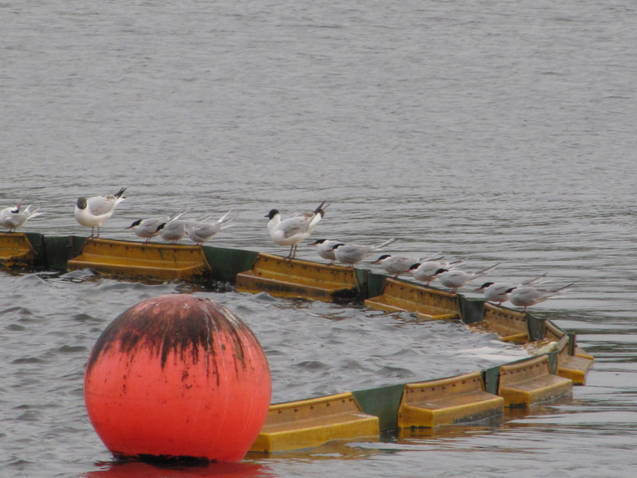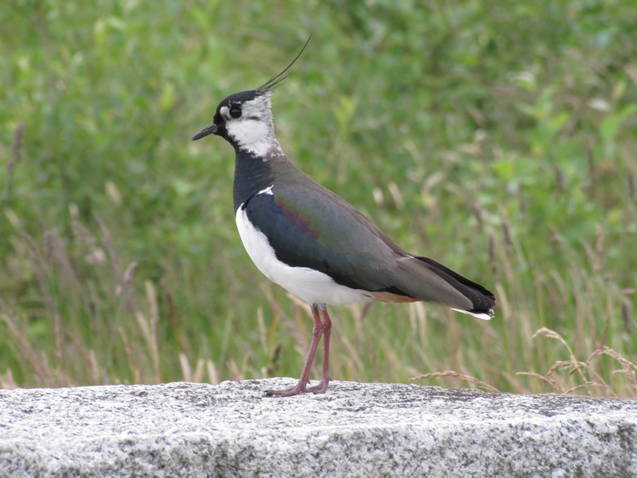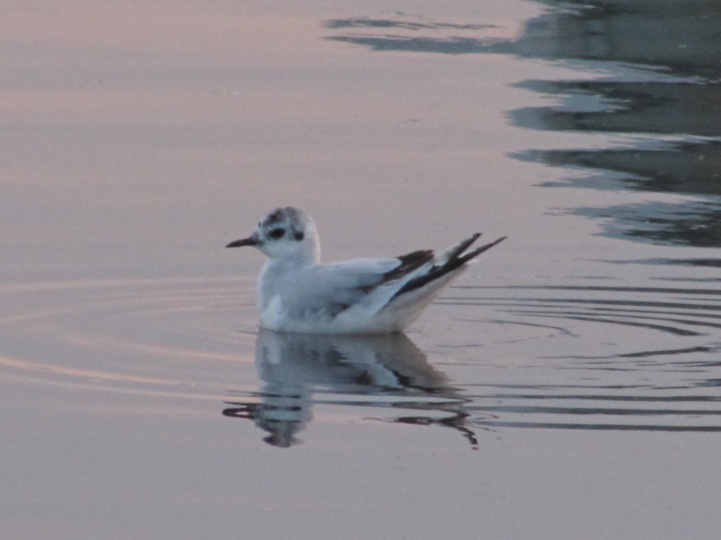Photos with this report (click to enlarge) | |||
 Common Tern |
 Lapwing |
 Little Gull |
|
Overview
I moved over to Greater Manchester as my main birding county in the noughties on a “free transfer” from Cheshire for a number of reasons - new horizons, wanting to explore the county of my birth, the desire to do some hardcore local patching and capitalising on the chance to really look at a site through the seasons, step forward Salford Docklands (referred to in this article as the patch), a site close to my heart as several members of my family were dockers here during the industrial years of the docks.
Doing a degree in Wildlife & Conservation at the University of Salford helped massively, both with my understanding of the flora & fauna of the county, & the wider conservation issues of the birding scene, & having quality sites such as the Irwell Valley, Buile Hill Park & The Salford Docklands on the doorstep !
In 2012 I kept a Greater Manchester year-list for the first time proper, although the main aim was a big year on Salford Docklands
January
The New Year kicked off with Nuthatch in Light Oaks Park in Salford, Great Spotted Woodpecker in Peel Park & a nice variety of wildfowl - a site record count of 13 Goosander on King George V Pool (KGVP) Wetlands & Estuary Bird Survey (WEBS), Goldeneye & Tufted Duck at a variety of sites, a small flock of Pochard on Chorlton Water Park, & a skein of c100 Pink-footed Geese over Pomona. Several visits to the Boothstown area of the Bridgewater Canal produced at least 3 Willow Tits, a bonus Green Woodpecker, 33 Lapwing, at least 5 Bullfinch, c50 Fieldfare & a “flycatching” Goldcrest. Sightings on a walk along the River Irwell from Agecroft Bridge to 13 Arches on a crisp morning were the overwintering Green Sandpipers, the semi-resident drake Gadwall & 9 singing male Song Thrushes
February
Wildfowl were again a feature, with River Irwell WEBS counts peaking with 63 Tufted Duck & 14 Goldeneye, my first Teal of the year, at Salford Docklands, where it would appear to be the first record for the site, & more small numbers of Pochard, 3 on KGVP & 15 on Scotmans Flash. Whilst on a “twitch” to this site for a red-head Smew, a flock of 30 Greylag Geese were seen stood on the ice. Also here, I was very lucky to co-find a 2nd-winter Iceland Gull (part of an influx of white-winged gulls), with more bonus birds on-site in the form of a Water Rail, Great Black-backed Gull, Kingfisher & a singing Reed Bunting. The new Meadows Nature Reserve, on the River Irwell, chipped in with a fly-over Skylark
March
The traditional mad March Dunham Park woodpecker hunt reflected a decent woodland population, 1 Lesser Spotted Woodpecker, 1 Green Woodpecker, 10 Great Spotted Woodpecker & 8 Nuthatch, whilst a count of 41 Tufted Duck was made around the park. My good luck with larids continued with sightings of 2-3 adult summer plumage Mediterranean Gulls on Salford Docklands. A feeding flock of Lesser Redpolls showed well along the Bridgewater Canal at Boothstown. A “heatwave” in late March saw 7 Common Buzzards soaring together in the heat haze, watched from Buile Hill Park overlooking The Docklands, & my first singing Chiffchaffs of the year, at Kersal Dale Local Nature Reserve
April
The majority of the month was spent on my patch, Salford Docklands, with migrants the theme, Wheatears, Common Sandpiper, Whitethroat, and, on 25th, a huge flock of c120 Arctic & Common Terns. The piece de resistance was a male Whinchat on Pomona Docks
May
On 1st, a first summer Little Gull appeared on Salford Wharf, and with the Whinchat made a double act that inspired the largest modern day twitch on the patch. A female Linnet on Pomona Docks was both a Docklands site tick & a Greater Manchester year-tick. The action picked up around the Manchester Ship Canal at Weaste. This area is the gateway to The Docklands & produced some magic moments, a pair of displaying Great Crested Grebes, a stunning male Yellow Wagtail picked up flying in from the west up the canal, then watched on Weaste ETW, a singing male Lesser Whitethroat in the canal-side bushes & a Hobby seen dashing in, causing chaos amongst the Swifts & hirundines, & catching prey. Elsewhere on The Docklands several species of waders occurred.
A trip to the south of England, to Wessex, to have a look at the re-introduction scheme Great Bustards, where 5 frisky male Bustards of varying ages were seen resting & feeding after a hard mornings’ lekking, and the drake Hooded Merganser at Radipole Lake RSPB Reserve - turning up on The Fleet as a youngster in 2007, this bird has made Radipole his home, & is particularly fond of the local female Tufted Ducks ! We caught up with this brightly-coloured American duck species on the area of the lake adjacent to Weymouth Harbour, other species on the trip, Stone Curlew, Tree Pipit, Cetti's Warbler, Whimbrel, Little Egret, Corn Bunting & Egyptian Goose, plus Goshawk on an RSPB TV screen in the New Forest
Two singing male Yellowhammers were watched on territory along the Bridgewater Canal between Altrincham & Dunham. The month was completed with a marathon Salford Docklands Bird Race from 4am to 6:15pm on the 31st, recording a superb 51 species
June
Much of June’s birding was spent monitoring breeding birds, especially on The Docklands
July
July was what many birders would call “plastic fantastic”, Egyptian Goose on Salford Docklands, the Northern Bald Ibis on the lush terrace & rooftops of Hattersley, Mandarin Ducks with chicks on Etherow Country Park & a Greylag Goose on Clowes Park Lake (a Salford tick)
August
A Greater Manchester year-tick came in the form of a party of 5 Shoveler at Altrincham ETW Pools, where I also enjoyed watching the late summer Green Sandpipers. Up on The Docklands, I spent much time monitoring the Lapwing numbers on the Manchester Ship Canal, with a peak of 42 birds, & Pomona saw another twitch, this time for a juvenile male Common Redstart that played hide & seek along Sea Buckthorn Avenue.
September
The month began with a bird for the purists, a juvenile American Black Tern, taxonomically complex but a total mega ! It was a joy to be able to watch this bird fluttering around Pennington Flash, with a juvenile Black Tern for very convenient comparison, completing a perfect autumnal birding scene
Passerine migration continued with a Wheatear on Pomona, Spotted Flycatchers & Tree Pipit on Horwich Moors (plus a Black Redstart just over the border in Lancs) & a Jay influx started on The Docklands
More interesting wildfowl continued to confuse & amuse - a Whistling Duck, perhaps Fulvous, on The Manns Pond at Greenfield sported a cute call, a very interesting diving action and a purple leg ring, while the female Wood Duck on the River Croal Weir, Moses Gate County Park was seen to have missing primary feathers
The temptation of a Pectoral Sandpiper on the Burton Mere RSPB Reserve (a site I had not visited previously) prompted an out of county twitch, combined with a trip down memory lane to Frodsham Marsh, a site I spent many happy days at during the 90’s, for Garganey and some wader watching
October
A determined effort was made to monitor The Docklands during October for migration. A total of over 2,000 passerines were recorded, including Coal Tit, Reed Bunting & Ring-necked Parakeet (all site firsts). Peel Park was the site of a big dip on Yellow-browed Warbler, a great find for an RSPB employee on a family walk through the park.
November
My first trip to Elton Reservoir since the 1991 Cinnamon Teal (anyone remember that bird?), saw Eurasian Wigeon, but a dip on Whooper Swan.
The invasion of Waxwings reached Ordsall, with large flocks around Monmouth Park, Ordsall Park & the Ordsall Community Cafe !
The “out of county twitching bug” was caught with the justification of “brushing up on identification pointers that can hopefully be of use one day on the local patch”. If any of the species seen – a cracking Lesser Yellowlegs & Wood Sandpiper on Aldcliffe Marshes near Lancaster, Hawfinch at Woodwell, & Desert Wheatear, Firecrest & a (co-found) Lapland Bunting in North Wales – ever turn up on the patch I now like to think that I would be ever so slightly more prepared !
December
To mix it up, another twitch, this time to “ducktastic” South-west Yorkshire, American Wigeon & Long-tailed Duck, Smew & Greater Scaup at Anglers Country Park, & a good glimpse of Bittern at the Old Moor RSPB Reserve.
Locally, the Bollington Barnacle Goose was dipped twice, a concerted effort was made in December on The Docklands, producing 3 late Greater Manchester year-ticks, Jack Snipe, Woodcock & Common Redshank, and the River Irwell WEBS saw 31 Goldeneye, my highest count of the year
So, the year was completed with 88 species on Salford Docklands, a record year-list for the site, and a Greater Manchester year-list of 109 species. During the year, I gained more knowledge of, and affection for, this land-locked county. Birding in Greater Manchester is very addictive, and I hope that this notebook encourages birders to visit our superb county.
Good birding,
James Walsh (aka The Mancunian Birder)
Manchester Ship Canal World Heritage
Salford Docklands Heritage & Nature Group. Email: salforddocklands@yahoo.com
All sightings relate to Salford Docklands during 2012 unless stated.
1. Mute swan
2. Pink-footed goose
3. Canada goose
4. Egyptian goose
5. Greylag Goose (Scotmans Flash)
6. Teal
7. Mallard
8. Gadwall (River Irwell)
9. Wigeon (Elton Reservoir)
10. Shoveler (ASF)
11. Mandarin (Etherow CP)
12. Tufted duck
13. Pochard (KGVP)
14. Goldeneye
15. Goosander
16. Smew (Scotmans Flash)
17. Cormorant
18. Grey heron
19. Little grebe
20. Great crested grebe
21. Sparrowhawk
22. Common buzzard
23. Kestrel
24. Hobby
25. Peregrine
26. Moorhen
27. Coot
28. Water Rail (Scotmans Flash)
29. Oystercatcher
30. Little ringed plover
31. Ringed plover
32. Lapwing
33. Common snipe
34. Jack Snipe
35. Woodcock
36. Common sandpiper
37. Green Sandpiper (River Irwell)
38. Redshank
39. Black-headed gull
40. Little gull
41. Mediterranean gull
42. Common gull
43. Lesser black-backed gull
44. Herring gull
45. Great Black-backed Gull (Scotmans Flash)
46. Iceland Gull (Scotmans Flash)
47. Common tern
48. Arctic Tern
49. Black Tern (Pennington Flash)
50. Feral pigeon
51. Woodpigeon
52. Collared dove
53. Ring-necked parakeet
54. Swift
55. Kingfisher
56. Great spotted woodpecker
57. Green Woodpecker (Boothstown)
58. Lesser Spotted Woodpecker (Dunham Park)
59. Treecreeper (Peel Park)
60. Nuthatch (Light Oaks Park)
61. Magpie
62. Jay
63. Jackdaw
64. Carrion crow
65. Rook (Bollington)
66. Goldcrest
67. Willow Tit (Boothstown)
68. Blue tit
69. Great tit
70. Coal tit
71. Skylark
72. Sand martin
73. Swallow
74. House martin
75. Long-tailed tit
76. Chiffchaff
77. Willow warbler
78. Blackcap
79. Lesser whitethroat
80. Common whitethroat
81. Waxwing
82. Wren
83. Starling
84. Blackbird
85. Song thrush
86. Mistle thrush
87. Redwing
88. Fieldfare (Boothstown)
89. Robin
90. Redstart
91. Whinchat
92. Wheatear
93. Spotted Flycatcher (Horwich Moors)
94. Dunnock
95. House sparrow
96. Yellow wagtail
97. Grey wagtail
98. Pied wagtail
99. Meadow pipit
100. Tree pipit (Horwich Moors)
101. Chaffinch
102. Greenfinch
103. Goldfinch
104. Siskin
105. Linnet
106. Lesser redpoll
107. Bullfinch
108. Reed bunting
109. Yellowhammer (Bridgewater Canal)
Also:
Controversial taxonomy
American Black Tern (Pennington Flash)
Controversial origins
Whistling Duck sp. (Greenfield)
North American Wood Duck (Moses Gate CP)
Northern Bald Ibis (Hattersley)